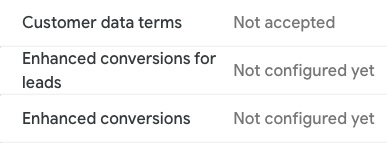Big changes are coming in 2024 to paid search. Chief among those is Google’s deprecation of third-party cookies by Q3. Advertisers will need to rely on their own first-party data. Artificial intelligence will change the way advertisers manage accounts. AI is an effective tool that complements advertisers’ efforts and cannot be ignored.
A strategy of “the more data, the better” will dominate.
First-party Data
Recent data-privacy restrictions (such as Apple Mail removing tracking parameters) confirm the importance of advertisers collecting and using their data. Effective data collection begins with the Google tag (formally called the global site tag). When placed sitewide, this short JavaScript tag allows for custom configurations, such as capturing email addresses and other user-provided info. The data is hashed to maintain users’ privacy.
The second data-collection step is via Google Ads’ enhanced conversions at Tools and Settings > Conversions > Settings. There are three items to configure:
- “Customer data terms,”
- “Enhanced conversions for leads,”
- “Enhanced conversions.”
Accept “Customer data terms” to use enhanced conversions. Advertisers should set up enhanced conversions (through Google Tag Manager) so Google Ads can match user-provided data. For example, through enhanced conversions, Google can match a customer’s email or phone number as provided on the conversion event (checkout) page.
“Enhanced conversions for leads” is helpful to advertisers tracking offline sales.

Collect data via Google Ads’ enhanced conversions, with three items to configure.
Artificial Intelligence
AI is upending search engines. Google Ads has already incorporated AI into its admin interface, including:
- “Automatically created assets,”
- “Image generator,”
- “AI-powered insights.”
“Automatically created assets” are available in individual campaign settings. The feature allows Google to create headlines and descriptions based on landing pages, domains, and existing ads. Microsoft Ads also has a similar feature called “auto-generated assets.” Along with testing new messaging, ACAs help increase the ad strength score, which likely results in more impressions. Still, advertisers should monitor ACAs closely and remove them as needed, anytime.
The AI-powered “Image generator” helps Performance Max campaigns. From an ad description, Google can create relevant images. In the example below, the AI generator produced images of sporting goods equipment based on my description.
Separately, advertisers can create videos based on provided templates, text, and images. In my testing, video quality is poor and unacceptable to brands. But it will presumably improve over time.

From a description (on the left), Google Ads can create relevant images, such as sporting goods equipment in this example. Click image to enlarge.
More Data
Google’s machine learning is extremely powerful and effective, provided it can access enough data. For example, a Responsive Search Ad needs at least 2,000 impressions across 30 days to display a performance rating. Highly segmented campaigns with too many ad groups will never meet that threshold.
Here’s an example. Assume a campaign for winter jackets has two hypothetical structures. The first structure has five unique ad groups averaging 30,000 impressions each. The second has just one group, consisting of all keywords from the five, for 150,000 impressions.
The single ad group would not have “green” in the ad copy from a search of “green winter jackets,” but it would still include messaging about winter jackets. Google could optimize this single group better because it has more data.
Furthermore, match types are becoming less important. Phrase and broad match keywords can trigger queries that don’t contain the terms. An exact match can show non-exact variations of the keyword. User signals beyond keywords increasingly influence what ads show.
The bottom line: Google Ads works best when given enough autonomy to learn, which requires the correct data. Advertisers seeking on-site purchases should optimize campaigns for that specific conversion (purchases), not any other, such as a contact-us submission or email signup. Bid strategies are more accurate and truer with target CPA and target ROAS goals.
via https://www.aiupnow.com
Matthew Umbro, Khareem Sudlow
